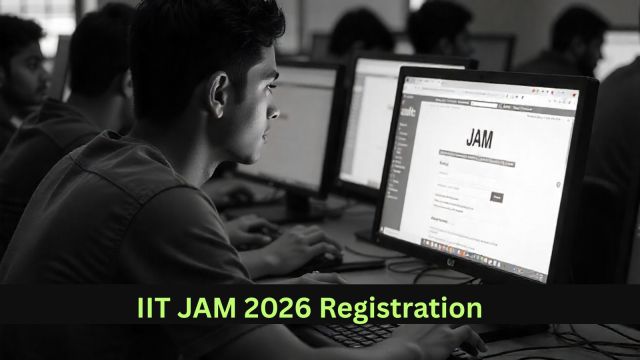JAM 2026: IIT Bombay starts registration; know how to apply, documents required & more
IIT JAM 2026 Registration: From required documents to how to apply and colleges which accept JAM scores, here’s everything you need to know to navigate the IIT JAM 2026 registration.
 With over 3,000 seats available for the 2026–27 academic session, aspiring candidates must gear up to complete their applications via the official JOAPS portal before the deadline on October 12, 2025. (Image: Freepik AI)
With over 3,000 seats available for the 2026–27 academic session, aspiring candidates must gear up to complete their applications via the official JOAPS portal before the deadline on October 12, 2025. (Image: Freepik AI)The Indian Institute of Technology (IIT) Bombay begins the registration process for the Joint Admission Test for Master’s (IIT JAM) 2026 on September 5, 2025. This national-level entrance exam opens doors to postgraduate programmes—including MSc, MSc-PhD dual degrees, and integrated PhDs—across 22 IITs and the Indian Institute of Science (IISc).
With over 3,000 seats available for the 2026–27 academic session, aspiring candidates must gear up to complete their applications via the official JOAPS portal before the deadline on October 12, 2025. From required documents to how to apply and colleges which accept JAM scores, here’s everything you need to know to navigate the IIT JAM 2026 registration.
IIT JAM 2026: Documents required
To apply for IIT JAM 2026, candidates must upload several key documents. All uploads must meet the specified dimensions and clarity standards, as mentioned in the brochure, to ensure successful application processing.
–Class 10 (SSC) marksheet or certificate is mandatory.
–Photograph must be recent, in colour, passport-sized, with a white or light background, and clearly show the full face without shadows, masks, or tinted glasses. It should be in JPEG/JPG format, sized between 50 kB and 200 kB. Poor-quality images may lead to rejection.
–For the signature, candidates must use black or dark blue ink inside on white paper, scan it professionally, and upload it in JPEG/JPG format (50 kB to 150 kB).
–Category certificates (OBC-NCL, EWS, SC, ST) must follow official formats and be issued after April 1, 2025. PwD candidates must submit valid disability certificates as per guidelines.
IIT JAM 2026: How to apply
Candidates can apply for IIT JAM 2026 through the JAM online application processing system (JOAPS) between September 5 and October 12, 2025.
Step 1: To begin, applicants must register with their name, email, mobile number, and password to the official website–jam2026.iitb.ac.in.
Step 2: Upon registration, an enrolment ID and OTP will be sent for login. Through JOAPS, candidates can fill out the application form, upload the required documents (photo, signature, category certificates, proof of date of birth).
Step 3: Pay the fee and download the form.
Applicants should use their personal email and mobile number throughout the process, as all communication will be sent via these channels. Only one application form is allowed per candidate—even for those appearing in two test papers. Multiple submissions may lead to rejection.
Candidates who qualify in the JAM 2026 examination will be eligible to apply for admission to academic programmes offered by participating institutes, provided they meet the required eligibility requirements and minimum educational qualifications (MEQs) as prescribed by the respective institutions.
IIT JAM 2026: Which institutions accept scores?
In addition to the IITs, the JAM 2026 score is also expected to be accepted by several other institutions including the Indian Institute of Science (IISc) Bengaluru, Indian Institutes of Science Education and Research (IISERs), Indian Institute of Petroleum and Energy (IIPE), Jawaharlal Nehru Centre for Advanced Scientific Research (JNCASR), and Centrally Funded Technical Institutions (CFTIs) such as the National Institutes of Technology (NITs), Indian Institute of Engineering Science and Technology (IIEST) Shibpur, Sant Longowal Institute of Engineering and Technology (SLIET), and Defence Institute of Advanced Technology (DIAT) through the Centraliaed Counselling for MSc/MSc (Tech.) Admission (CCMN) process.
IIT JAM 2026: Exam pattern
JAM 2026 for all the test papers will be conducted as a Computer-Based Test (CBT), where the candidates will be shown the questions in a random sequence on a computer screen. The duration of the examination will be three hours.
Section A contains a total of 30 MCQs involving 10 questions of one mark each and 20 questions of two marks each. Section A consists of negative marking. Section B contains a total of 10 Multiple Select Questions (MSQs) carrying two marks each. Section C contains a total of 20 Numerical Answer Type (NAT) questions, involving 10 questions of one mark each and 10 questions of two marks each. Sections B and C do not have any negative marking.
- 01
- 02
- 03
- 04
- 05































